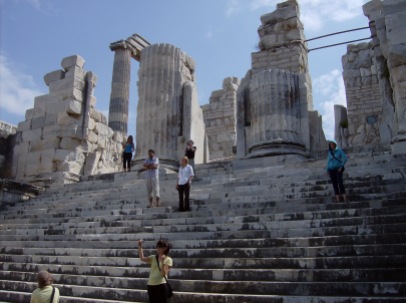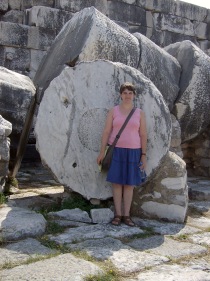
Temple of Apollo at Didyma (Miletus). Photo by Alison Innes.

Temple of Apollo at Didyma (Miletus). Photo by Alison Innes.

Temple of Apollo at Didyma (Miletus). Photo by Alison Innes.

Tunnel into the inner sanctuary at the Temple of Apollo at Didyma (Miletus). Photo by Alison Innes.

Inside the Temple of Apollo at Didyma (Miletus). Photo by Alison Innes.

Inside the Temple of Apollo at Didyma (Miletus). Photo by Alison Innes.

Inside the Temple of Apollo at Didyma (Miletus). Photo by Alison Innes.

Inside the Temple of Apollo at Didyma (Miletus). Photo by Alison Innes.

In the right light, a faint etching of a builder’s diagram is visible on this interior wall. Temple of Apollo at Didyma (Miletus). Photo by Alison Innes.

Inside the Temple of Apollo at Didyma (Miletus). Photo by Alison Innes.

A forest of massive columns surrounds the Temple of Apollo at Didyma (Miletus). Photo by Alison Innes.

Column drums at the Temple of Apollo at Didyma (Miletus). Photo by Alison Innes.

Storks nest on a reconstructed column at the Temple of Apollo at Didyma (Miletus). Photo by Alison Innes.

Temple of Apollo at Didyma (Miletus). Photo by Alison Innes.

Hellenistic gorgon’s head at the Temple of Apollo at Didyma (Miletus). Photo by Alison Innes.

Approach to the Temple of Apollo at Didyma (Miletus). Photo by Alison Innes.
Above: As promised in this week’s podcast, here are a few of Alison’s photos from a 2009 visit to the Temple of Apollo at Didyma (just south of Miletus). It is impossible to adequately convey the massive scale of the temple in photographs! The temple is approached by six steps and is surrounded by a forest of massive columns. Column drums as a wide as a person is tall and column flutes are wide enough to fit a human head. Unusually for a Greek temple, the interior is entered through a narrow tunnel.
This episode we continue with our close analysis of the Homeric Hymn to Apollo. We discuss Apollo’s birth story and the festival on Delos in his honour.
We also have some listener mail!
https://www.podbean.com/media/player/d94w3-6aa18c?from=yiiadmin
Download this episode (right click and save)
Source Passages
Homeric Hymn to Apollo
Translation Sources
Homeric Hymn to Apollo. Translated by Susan C. Shelmerdine. Focus Publishing: 1995.
Patrons
These people like our show so much, they decided to support us on Patreon! Thank you so much!
Aven McMaster & Mark Sundaram (Alliterative); Joelle Barfoot; Erika Dilworth
Join us on Twitter @InnesAlison and @darrinsunstrum or #MythTake.
We’re a part of the #HumanitiesPodcasts podcasting community. Check out the hashtag and follow @HumCommCasters to find many more engaging and knowledgeable podcasts.
We’re on Facebook! Give us a like, let us know what you think, and follow along at MythTake.
Subscribe on iTunes or Google Play so you don’t miss an episode! Find our RSS on Podbean.
Like what you hear? Please support us on Patreon.
This week’s theme music: “Super Hero” by King Louie’s Missing Monuments from the album “Live at WFMU” (2011). Used under Creative Commons license. Music used under Creative Commons license and available from Free Music Archive.



















